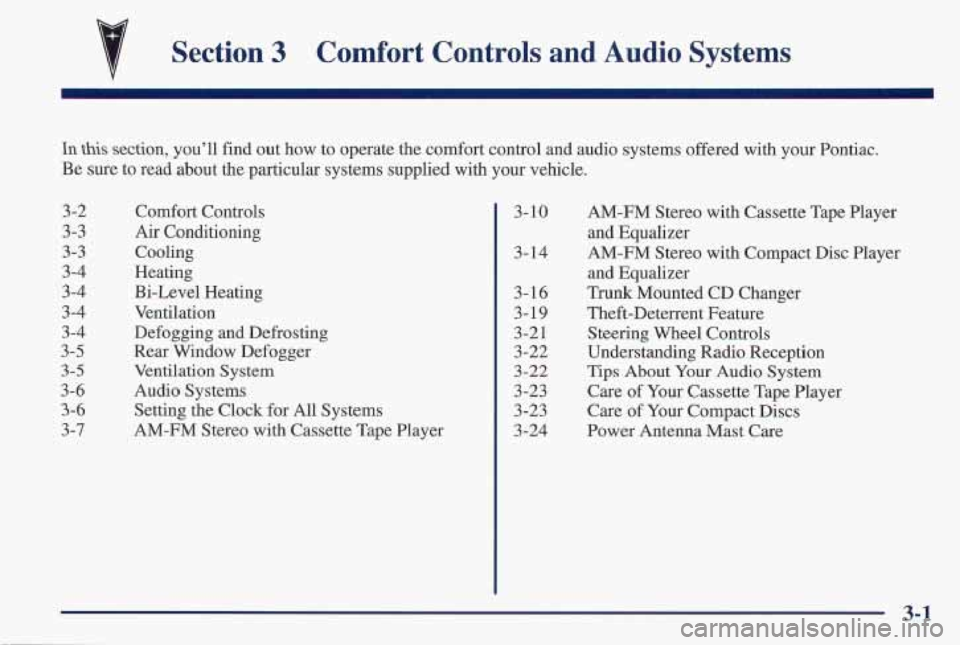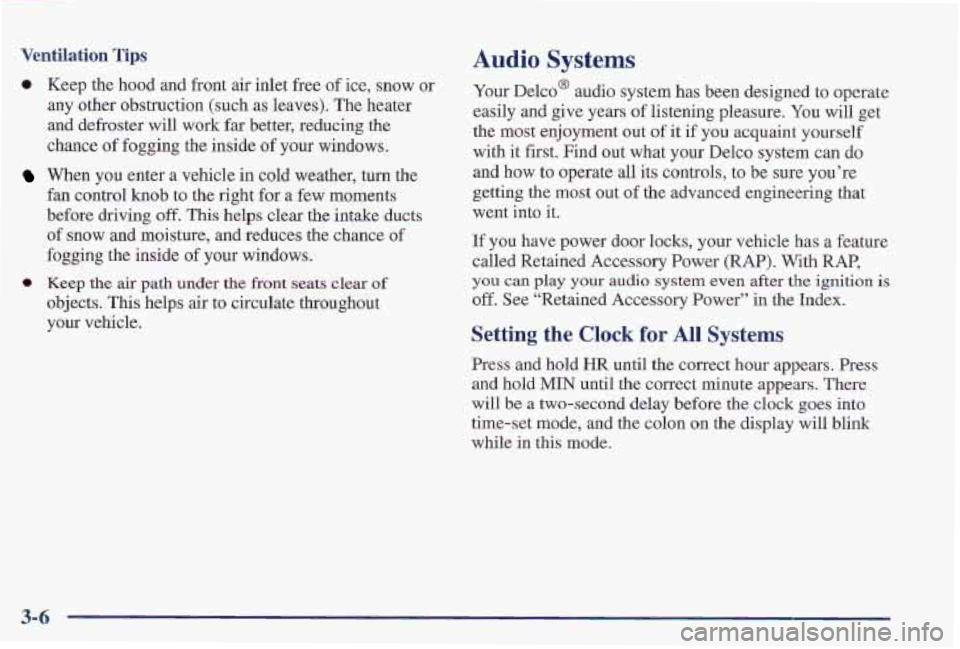window PONTIAC FIREBIRD 1997 User Guide
[x] Cancel search | Manufacturer: PONTIAC, Model Year: 1997, Model line: FIREBIRD, Model: PONTIAC FIREBIRD 1997Pages: 410, PDF Size: 19.2 MB
Page 111 of 410

The door key unlocks the panels. The lock is over the
front
door window. Turn the key to the left to unlock
the panel. Then
push on
the release handle to unlatch the panel. Lift
the outer edge
of the panel and pull it toward you. Then
carry the panel
to the rear of the vehicle for storage.
2-62
Page 120 of 410

Raising Your Convertible Top
1. Park on a level surface. Set the parking brake firrnly.
If you have an automatic transmission, shift into
PARK
(P). If you have a manual transmission, shift
into REVERSE (R). The ignition must be in the ACC
or RUN position or RAP must be on. Lower both sun
visors. Lower both windows at least
3 inches (8 cm). If
the boot cover is in place, it must be removed first.
3. Remove the two side pieces of the boot cover
by lifting the rear cover and sliding them out
of
their slots.
2. Open the trunk. Remove the middle piece of the
cover by pushing in on the latch and lifting up on
the cover.
Page 124 of 410

A. Fog Lamp Switch (If Equipped)
B. Main Lamp Control
C. Air Vent
D. Instrument Cluster
E.
Horn
E Audio System
G. Glove Box
H. Comfort Controls
I. Cupholder
J. Parking Brake Lever
K.
Storage Console
L. Rear Window Defogger Switch
M. Convertible Top Switch (Automatic) (If Equipped)
N. Traction Control System Switch or Second Gear
0. Cigarette Lighter
P. Shift Lever
Q. Ashtray (Automatic Transmission)
R. Convertible Top Switch (Manual) (If Equipped)
S. Steering Wheel Controls
T. Remote Hatch Release
Start
Switch (If Equipped)
Page 140 of 410

Section 3 Comfort Controls and Audio Systems
In this section, you’ll find out how to operate the comfort control and audio systems offered with your Pontiac.
Be sure to read about the particular systems supplied with your vehicle.
3-2
3-3
3-3
3-4
3-4
3-4
3
-4
3-5
3-5
3-6
3 -6
3-7
Comfort Controls
Air Conditioning
Cooling
Heating
Bi-Level Heating
Ventilation
Defogging and Defrosting
Rear Window Defogger
Ventilation System
Audio Systems Setting the Clock
for All Systems
AM-FM Stereo with Cassette Tape Player
3-10
3- 14
3-16
3-19
3-2
1
3-22
3-22
3-23
3-23
3-24 AM-FM Stereo with Cassette
Tape Player
and Equalizer
AM-FM Stereo with Compact Disc Player
and Equalizer
Trunk Mounted
CD Changer
Theft-Deterrent Feature
Steering Wheel Controls
Understanding Radio Reception
Tips About Your Audio System
Care
of Your Cassette Tape Player
Care
of Your Compact Discs
Power Antenna Mast Care
3-1
Page 142 of 410

Air Conditioning (If Equipped)
I
The air conditioning system uses the same controls as
the heating system, except that the air control knob has
two extra settings, described below.
MAX: Provides maximum cooling or quick cool-down
on very hot days. This setting recirculates most of the air
inside your vehicle.
If it is used for long periods of time,
the air may become dry. This setting directs air through
the upper air vents,
A/C: Use for normal cooling on hot days. This setting
cools outside
air and c‘kts it through the upper air vents.
The i-111- conditioner cumpressor operates in MAX, AIC,
BI-LEVEL, BLEND and DEFROST when the outside
temperature is above freezing. When the
air conditioner
is on,
you may sometimes notice slight changes in
your vehicle’s engine speed and power. This is normal
because the system is designed to cycle the compressor
on and
off to keep the desired cooling and help
fuel economy.
Cooling
The air conditioner works best if you keep your
windows closed. On very
hot days, open the windows
just long enough for the hot air to escape.
1. Turn the air control knob to A/C for normal cooling.
For faster cooling, move the
knob to MAX.
2. Turn the temperature control knob to a
comfortable setting.
3. Move the fan control knob to the desired speed.
Page 143 of 410

Heating
The heater works best if you keep your windows closed
while using it.
1. Turn the air control knob to HEATER.
2. Turn the fan control knob to the desired speed.
3. Turn the temperature control knob to a
During initial start-up only, if your vehicle is equipped
with
an optional engine coolant h'eater, you can use it in
cold weather (around +20°F/-8"C or lower) to improve
heater performance on start up, Because an engine
coolant heater
warms the engine coolant, your vehicle's
heating
system can more efficiently pro'vide heat for the
passenger area of your vehicle. See "Engine Coolant
Heater" in the Index.
comfortable
setting.
Bi-Level Heating
You may want to use bi-level heating on cool, but sunny
days. This setting directs cool air toward your body and
warmer air toward your feet. 1,
Turn the air control
knob to BI-LEVEL.
2. Turn the temperamre control knob to a
3. Turn the fan control knob to the desired speed.
comfortable
setting.
Ventilation
For mild outside temperatures when little heating or
cooling is needed, you can still direct outside air through
your vehicle.
I, Turn the air control knob to VENT.
2. Turn the temperature control knob to a
3. Turn the fan control knob to the desired speed.
co'mfortable setting.
Defogging and Defrosting
1. 'Turn
the air cantrol knob to DEFROST.
2. Turn the temperature control knob to the
3. Turn the fan control knob to the desired speed.
desired setting.
3-4
Page 144 of 410

Rear Window Defogger (If Equipped) Ventilation System
The
rear window defogger
uses
a warming grid to
remove fog from
the rear window.
Press the switch to turn on
the defogger. An indicator
light will come on to remind
you that the defogger is on.
I
The defogger will turn off automatically after about
10 minutes of use. If you turn it on again, the defogger
will operate for about five minutes only. You can also
turn the defogger off by pressing the switch again.
Do not attach anything like a temporary vehicle license
or
a decal across the defogger grid on the rear window.
NOTICE:
Don’t use a razor blade or something else sharp
on the inside of the rear window. If you do, you
could cut or damage the warming grid, and the
repairs wouldn’t be covered by
your warranty.
Your Pontiac’s flow-through ventilation system supplies
outside air into the vehicle when it is moving. Outside
air will
also enter the vehicle when the blower fan
is running.
3-5
Page 145 of 410

Ventilation Tips
a Keep the hood and front air inlet free of ice, snow or
any other obstruction (such
as leaves). The heater
and defroster will work far better, reducing the
chance
of fogging the inside of your windows.
When you enter
a vehicle in cold weather, turn the
fan control
knob to the right for a few moments
before driving
off. This helps clear the intake ducts
of snow and moisture, and reduces the chance of
fogging
the inside of your windows.
Keep the air path under the rront sems clear of
objects. This helps air to circulate throughout
your vehicle.
Audio Systems
Your Delco@ audio system has been designed to operate
easily and give years
of listening pleasure. You will get
the most enjoyment out
of it if you acquaint yourself
with it first. Find out what your Delco system can do
and how to operate all its controls,
to be sure you’re
getting the most out o’f the advanced ‘engineering that
went into it.
If you have power door locks, your vehicle has a feature
called Retained Accessory Power
(RAP). With RAP,
you can play your audio system even after the ignition is
off. See “Retained Accessory Power” in the Index.
Setting the Clock for All Systems
Press and hold HR until the correct hour appears. Press
and hold MIN until the correct minute appears. There
will
be a two-second delay before the clock goes into
time-set mode, and the colon on the display will blink
while
in this mode.
3-6
Page 187 of 410

Once you are moving on the freeway, make certain you
allow a reasonable following distance. Expect to move
slightly slower at night.
When you want to leave
the freeway, move to the proper
lane well in advance.
If you miss your exit, do not,
under any circumstances, stop
and back up. Drive on to
the next exit.
The exit ramp can
be curved, sometimes quite sharply.
The exit speed is usually posted.
Reduce
your speed according to your speedometer, not
to your sense of motion. After driving for any distance
at higher speeds, you may tend to think you are going
slower
than you actually are,
Before Leaving on a Long Trip
Make sure you’re ready. Try to be well rested. If you
must start when you’re not fresh
-- such as after a day’s
work
-- don’t plan to make too many miles that first part
of the journey. Wear comfortable clothing and shoes you
can easily drive in,
Is your vehicle ready for a long trip? If you keep it
serviced and maintained, it’s ready
to go. If it needs
service, have it done before starting out. Of course,
you’ll find experienced and able service experts in
Pontiac dealerships all across North America.
They’ll be
ready and willing to help if you need it.
Here are
some things you can check before a trip:
0
a
a
a
a
0
Windshield Washer Fluid: Is the reservoir full? Are
all windows clean inside and outside?
Wiper Blades: Are they in good shape?
Fuel, Engine Oil, Other Fluids: Have you checked
all levels?
Lamps: Are they all worlung? Are the lenses clean?
Tires: Th’ey are vitally important to a safe,
trouble-free trip.
Is the tread good enough for
long-distance driving? Are the tires all inflated to the
recomended pressure?
Weather Fureecasts: What’s the weather outlook
along your route? Should you delay
your trip a short
time to avoid a major storm system?
Maps: Do you have up-to-date maps?
4-22
Page 194 of 410

A CAUTION: ..
Snow can trap exhaust gases under your vehicle.
This can cause deadly CO (carbon monoxide) gas
to get inside.
CO could overcome you and kill
you. You can’t see
it or smell it, so you might not
know it is in your vehicle. Clear away snow from
around the base of your vehicle, especially any
that
is blocking your exhaust pipe. And check
around again from time to time to be sure snow
doesn’t collect there.
Open
a window just a little on the side of the
vehicle
that’s away from the wind. This will help
keep
CO out.
Run your engine only as long as you must. This saves
fuel. When you run the engine, make
it go a little faster
than just idle. That
is, push the accelerator slightly. This
uses less fuel for the heat that you get and it keeps the
battery charged. You will need a well-charged battery to
restart the vehicle, and possibly for signaling later
on
with your headlamps. Let the heater run for awhile.
Then, shut the engine
off and close the window almost
all the way to preserve the heat. Start the engine again
and repeat this only when you feel really uncomfortable
from the cold. But do
it as little as possible. Preserve the
fuel as long as you can. To help keep warm, you can get
out of the vehicle and do some fairly vigorous exercises
every half hour or so until help comes.
4-29